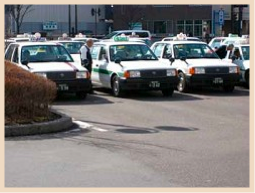
Todd Jay Leonard, Blog


Recently, a reader wrote to ask what it is about Japan that I like so much. Immediately, a number of things came to mind. As I started to mentally list the aspects I find especially attractive about Japan, I decided to make "Todd's To-10 List of Things Japanese." So, over the next several installments of this column, I am going to comment upon the things I really appreciate about Japan.
Certainly, high on the list are taxis. In particular, Japanese taxi drivers are clean, quick, and courteous. Often the drivers wear nicely pressed uniforms, hats and white gloves. The taxi service that I regularly use instructs its drivers to introduce themselves in the most polite form of Japanese, and they nearly always greet me by name.
Competition is quite keen within the taxi industry in Japan, so companies do whatever they can to stand out from the others. Some taxi services offer discounts, coupons or other similar incentives to attract repeat customers. Lately it has become trendy in my city for companies to offer customers a "user" card, whereby points are accrued each time the taxi service is used. These points can then be exchanged for different prizes or products.
One standard feature that all Japanese taxis are equipped with is automatic doors which are opened and shut for the customer remotely by the driver. A lever is used to open the door for the fare to enter, and after arriving at the destination is used again to allow the passenger to exit. The door is then automatically closed after the customer leaves.
This may seem like a frivolous gesture based on courtesy and politeness, but it has a very practical side to it. Since most Japanese people carry some sort of bag or briefcase, it is quite helpful to have the door opened and closed, allowing the passenger to enter and exit the vehicle without having to juggle items awkwardly or to touch anything that others have touched, such as door handles.
Once when I visited New York from Japan, I exited the taxi and just walked away. The driver yelled at me to shut the door. It embarrassed me because I had become so accustomed to Japanese taxis that I had forgotten that this is a custom unique to Japan.
Also, taxis in Japan are squeaky clean. The seats are all covered in white seat covers, making it easier to slide in and out. The inside and outside of the taxis are meticulously maintained. Never do I see a taxicab that is banged up, dented, or dirty.
When traveling outside of Japan, I realize how spoiled I am here with the high level of service the customer receives from the taxi companies. Often American taxis are seemingly on their last legs, with seats so grimy that it makes you wonder what was there before you. Also, drivers are not always the most honest with unsuspecting fares, literally "taking them for a ride."
In Japan, since drivers are paid a regular salary that is not dependent upon how many fares they pick up, rarely is a customer driven around aimlessly in order to pad the meter. In fact, it seems that drivers go out of their way to get to the destination as quickly as possible.
On occasion, when a driver has either made a wrong turn, can't readily find the destination, or has taken a route that ended up in bumper-to-bumper traffic, he will shut the meter off and ask the customer to pay what would be a fair price for only the distance that was expected to be traveled. Now, that's integrity.
Another unique trait of Japanese taxis is the type of fuel they use. Nearly all taxis use propane gas instead of gasoline. This custom most likely started as a way to avoid high fuel costs during the energy crisis in the 1970s. I am sure that with the recent surge in the price of oil, which directly affects gasoline prices, it is a bit more economical and energy efficient to use natural gas as a fuel source. Japanese taxis often idle in queues waiting for the next fare, so this clean-burning fuel is not nearly as damaging to the atmosphere as fossil fuels are.
Japanese people are generally very orderly when waiting in lines of any sort. Train stations nearly always have a taxi stand available for people who need to get to their final destination after taking a train. There is never any pushing, shoving or cutting in these lines. People very calmly wait as each person in front of them is collected by the next available taxi.
This is certainly not the case in many other countries. On a recent trip to Thailand, I was so frustrated at how some people would cut in line at the taxi stand. These types of people have the attitude of "each man for himself." Underhandedly trying to hail a taxi several feet in front of another person who has been waiting longer or grabbing a taxi out from under another person's nose are examples of poor taxi etiquette.
Rarely does this happen in Japan. Of course, politeness is a well-known Japanese cultural trait, and such behavior would be unseemly there; but it is also unnecessary, because normally it is so easy to catch a cab. Per capita, there seems to be such an abundance of taxis in Japan that hailing one is nearly a statistical certainty. Exceptions would be after a major sporting event where a barrage of people are clamoring to find a taxi or during a rainy-season deluge when people are trying to get out of the weather. Nearly always, however, after hardly any time at all, an empty taxi with its telltale illuminated red meter comes cruising down the street.
Taxi fares in Japan do seem pricey to the uninitiated, typically starting at around $5 to $6 for just entering the cab. The total cost of the ride depends upon how far you need to go. The first two kilometers is included in the base price, and the fare then periodically increases around 70 to 80 cents for each additional 500 meters traveled. It is seemingly based on time as well, because the meter does increase while sitting idly for an extended period. There also is an additional charge of around 20 percent added to fares from late at night until early morning.
Inebriated passengers who happen to heave the prior festivities out the window and onto the side of the taxi are, of course, charged an additional fee for the cleanup of the taxi. Years ago I heard of a passenger being given a bucket of water to rinse the taxi by a polite driver so the customer wouldn't be charged for the cleanup. This sums up the professional attitude of the majority of taxi drivers in Japan. They demonstrate a high level of patience (in most instances) and in my experience, display an incredible amount of integrity for their work.
As the customer leaves the taxi, the driver always reminds the person not to forget his or her belongings. However, if an item is mistakenly left in a taxi by a passenger, chances are in the customer's favor of having the item returned.
If I am returning from grocery shopping, the driver always assists me in carrying the bags of groceries into the house. The taxi service I use can have a taxi dispatched to my home in a matter of minutes. I barely get off the phone and put my coat on, when the doorbell rings, announcing the taxi's arrival.
Now, that's what I call service!
By TODD JAY LEONARD
Columnist
Hail to taxicabs
Top-10 list of things Japanese begins
Monday, April 9 , 2007







